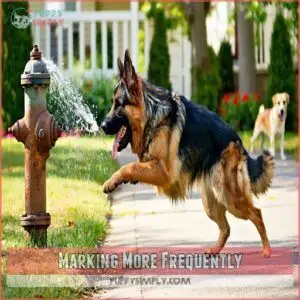This site is supported by our readers. We may earn a commission, at no cost to you, if you purchase through links.

Your furry friend can detect a female’s scent from up to three miles away, triggering intense reactions. They’ll become restless, pace constantly, and might even lose interest in their favorite treats.
Watch for increased whining, excessive drooling, and escape attempts as those powerful hormones kick in.
Even well-trained dogs may suddenly ignore commands and mark territory more frequently.
While these behaviors are natural, understanding the right management techniques can help you maintain control and keep everyone safe and comfortable.
Table Of Contents
- Key Takeaways
- Male Dogs Behavior Around Females in Heat
- What Happens to Male Dogs Around Females in Heat
- Recognizing Behavioral Changes in Male Dogs
- Managing Male Dog Behavior During a Female’s Heat Cycle
- The Impact of Neutering on Male Dog Behavior
- Strategies to Keep Male Dogs Calm During a Female’s Heat Cycle
- Safety and Responsibility Around Female Dogs in Heat
- Permanent Solutions for Managing Male Dogs’ Behavior
- Managing Male Dog Behavior Long-Term
- Frequently Asked Questions (FAQs)
- Do male dogs go into heat?
- What happens when a female dog is in heat?
- Can a male dog approach a female in heat?
- How to calm a male dog when a female is in heat?
- Do male dogs get agitated when a female is in heat?
- How to calm a male dog when a female dog is in heat?
- How do I tell if my male dog is going through puberty?
- How do you know if a male dog is in heat?
- Do female dogs flirt on heat?
- How do male dogs act when female is in heat?
- Conclusion
Key Takeaways
- Your male dog can detect a female in heat from up to 3 miles away, triggering intense behaviors like restlessness, excessive drooling, whining, and marking territory more frequently.
- You’ll need to increase supervision and exercise during heat cycles, as your male dog may try to escape, become aggressive with other males, or ignore basic training commands.
- You can manage your dog’s behavior by using scent blockers, adjusting walking schedules to quieter times, and creating physical barriers between males and females.
- You’ve got permanent solutions available like neutering your male dog or working with female dog owners to coordinate spaying, which can significantly reduce hormone-driven behaviors.
Male Dogs Behavior Around Females in Heat
You’ll notice your male dog turn into quite the Romeo when he catches a whiff of a female in heat, as his powerful nose can detect her scent from up to three miles away.
If you’ve got an unneutered male dog, you’ll need to keep an eye on his behavior during these times, since his natural instincts can make him restless and determined to find his potential mate, driven by his natural instincts.
Natural Instincts and Hormonal Changes
When your male dog catches a whiff of a female in heat, powerful pheromone responses kick in like a light switch.
His body surges with hormones, triggering intense mating cycles that can last for weeks.
These chemical signals can travel for miles, awakening primal instincts that transform your usually chill companion.
Think of it like nature’s GPS – his brain and body are suddenly laser-focused on one mission.
Understanding dog behaviour is essential in addressing the challenges that arise during such situations.
Importance of Managing Behavior
Living with an intact male dog requires mastering behavioral control when females are in heat.
It’s not just about avoiding surprise puppies – your dog’s canine psychology can shift dramatically, leading to challenging situations.
- Male dog aggression spikes can create dangerous encounters with other dogs
- Emotional stability decreases as hormones surge, causing excessive whining and escape attempts
- Training methods need adjustment since even well-behaved dogs may ignore commands
Understanding these challenges helps maintain socialization techniques that keep everyone safe.
What Happens to Male Dogs Around Females in Heat
You’ll notice your male dog transform into a lovesick teenager when a female in heat is nearby, as powerful pheromones can trigger intense behavioral changes from up to three miles away.
Your normally well-behaved pup might suddenly become restless, vocal, and determined to find the source of those irresistible scents, making this time challenging for both you and your four-legged friend.
Heightened Agitation and Anxiety
You’ve probably noticed your male dog acting like he’s suddenly lost his cool – blame those powerful heat hormones in the air.
Male dogs experience serious emotional distress when they catch a whiff of a female in heat, leading to some pretty dramatic behavioral outbursts.
Watch for these anxiety triggers that signal your boy’s picking up those irresistible scents:
- Intense pacing paired with non-stop whining, even if he’s normally Mr. Calm-and-Collected
- Completely ignoring his favorite treats and meals, which can trigger panic attacks
- Heavy panting and excessive drooling that seems out of place for the weather
This stress isn’t just an act – it’s your pup’s natural response to some seriously powerful hormonal signals.
Increased Interest in Mating
When a female dog goes into heat, a powerful wave of pheromone attraction transforms your male dog into a love-struck Romeo.
Like a moth to a flame, your pup’s mating instincts kick into overdrive, with his nose becoming a finely-tuned radar for canine romance.
Understanding the dog neutering process can help mitigate such behaviors, as it reduces the dog’s urge to mate.
| Behavior Sign | What It Means |
|---|---|
| Intense Focus | Your dog zeroes in on female scent |
| Escape Artist | Attempts to break free to find mate |
| Physical Signs | Male arousal becomes visible |
| Energy Spike | Restlessness and increased activity |
| Nose Work | Constant sniffing and tracking |
Urine Marking and Vocalization
Beyond physical attraction, male dogs communicate through two distinctive behaviors: marking and vocalization.
That sweet pup who rarely makes a peep might start whining, barking, or even howling – his way of sending vocal cues to females in heat.
Watch for increased urine spraying too – he’ll mark vertical surfaces like trees and posts way more than usual.
Think of these pheromone signals as his personal dating profile, broadcasting his presence to potential mates.
While this scent communication is natural, it can become excessive.
Consider using specialized behavior sprays or consulting your vet if the marking behavior becomes problematic.
Recognizing Behavioral Changes in Male Dogs
You’ll notice your male dog transform from a well-behaved companion into a lovesick teenager when he catches the scent of a female in heat.
Even the most obedient pup can suddenly become distracted, restless, and determined to follow his nose when those powerful pheromones come calling.
Increased Aggressiveness
Your male dog’s sweet nature can flip like a switch when females in heat are nearby.
Pack dynamics and social hierarchy kick in as hormones surge, triggering male dog aggressive behavior.
Here’s what you might notice:
- Snarling or lunging at other males, showing dominance issues
- Guarding territory more intensely than usual
- Displaying fear factors through defensive posturing
- Breaking normal intact male dog aggression patterns, even with familiar dogs
This change in behavior is often caused by dog behavior changes that occur when a female dog is in heat, which can be understood through resources like dog behavior changes, highlighting the impact of a female dog in heat on pack dynamics.
Roaming Tendencies
Almost every male dog becomes a mini Houdini when they catch a whiff of female pheromone triggers.
These escape artists can detect potential mates from miles away, turning your usually well-behaved pup into an adventurous wanderer.
Strengthen your yard security with dig-proof fencing and consider indoor enrichment activities during peak heat cycles.
Keep tight leash control on walks to prevent unexpected bolting behavior.
Marking More Frequently
Notice your male dog suddenly turning every walk into a bathroom marathon? That’s scent marking in overdrive – a clear sign he’s picked up on a female in heat nearby.
Like a four-legged GPS, he’s using his urine to broadcast his presence.
Here’s what’s really happening when your pup gets mark-happy:
- His territorial behavior intensifies through frequent urination
- Each spot becomes a canine communication hotspot
- His marking spots carry stronger scents than usual
- He’ll revisit previously marked areas more often
- You’ll notice increased sniffing and circling before marking
Think of it as his version of posting "single and ready to mingle" signs around the neighborhood!
Lack of Focus and Concentration
Your male dog’s behavior around females in heat can turn him into a furry ball of distraction.
When those hormones kick in, you’ll notice significant concentration issues – even the best-trained pups struggle to focus on basic commands.
This attention deficit isn’t just frustrating; it’s a clear sign your dog’s mind is elsewhere.
You might find him pacing, whining, or completely ignoring his favorite toys. Think of it like a teenager with their first crush – everything else becomes background noise.
Running through familiar training exercises can help combat this mental fatigue and keep his mind engaged.
Managing Male Dog Behavior During a Female’s Heat Cycle
You’ll need a solid game plan when your male dog starts acting like a love-struck teenager around a female in heat.
With the right mix of exercise, supervision, and smart management techniques, you can help your furry Romeo stay calm and focused during this challenging time.
Increased Exercise and Mental Stimulation
Physical activity and mental games are your best allies when managing a male dog around females in heat.
Take your buddy for longer walks and dog running sessions to burn that extra energy. Mix up exercise routines with fetch, agility courses, or tug-of-war – they’re great for stress relief.
For mental stimulation, try puzzle toys or scent games that’ll keep his mind occupied. Interactive feeders turn mealtime into play therapy, making him work for treats while staying focused.
Using dog puzzle toys can be particularly effective in challenging and engaging your dog.
Regular dog playtime and varied activities help channel that restless energy into positive behavior.
Supervision and Separation
The art of managing male dogs around females in heat comes down to smart separation and constant supervision.
Think of it like setting up a teen’s first dating rules – firm boundaries keep everyone safe and happy.
The strategy involves several key steps:
- Create designated "no-go zones" with secure dog fencing to prevent escape attempts
- Set up a cozy isolation room with engaging toys and comfort items
- Schedule alternating outdoor times to maintain safe distancing
- Use baby gates and separate entrances for supervised interactions
- Monitor male dog whining and body language for stress signals
Remember, male dogs in heat behavior can change rapidly, so stay alert, and a well-planned separation strategy beats dealing with an unexpected litter or aggressive encounters between determined suitors.
The Impact of Neutering on Male Dog Behavior
If you’re wondering whether neutering will help calm your male dog’s frisky behavior around females in heat, you’ll be pleased to know it often does the trick.
Getting your boy "fixed" can substantially reduce those hormone-driven urges that make him act like a lovesick teenager whenever a female dog in heat is nearby, which can be attributed to the significant impact of neutering on his overall behavior, especially around females, showing the effectiveness of the procedure in addressing frisky behavior.
Reduced Aggression and Hormonal Drive
Managing your male dog’s behavior during heat cycles can feel overwhelming, but neutering offers a proven path to calmer behavior.
Your furry friend’s male dog aggression typically decreases substantially after the procedure, while his overwhelming drive to roam and mate settles into more manageable patterns.
You’ll notice positive changes in hormone balance and scent management, making daily life more peaceful for both you and your companion.
Understanding the neutering process is key to making informed decisions about your dog’s health and well-being.
Health Benefits and Myths
Beyond curbing those wild urges around females in heat, neutering offers significant health benefits backed by medical research.
Your male dog’s behavior and wellness improve dramatically post-surgery.
Common myths suggest neutering leads to:
- Lazy, couch-potato pups who lose their playful spark
- Weight gain from slowed metabolism
- Personality changes making them less protective
- Loss of hunting or working abilities
Science says otherwise – these changes rarely happen.
Instead, neutering reduces prostate issues and certain cancers while maintaining your dog’s energy levels.
Talk with your vet about how the procedure could benefit your specific pup’s situation.
Strategies to Keep Male Dogs Calm During a Female’s Heat Cycle
You’ll need proven strategies to keep your male dog from turning into a love-struck Romeo when there’s a female in heat nearby.
Whether you’re dealing with your own dogs or neighborhood pups, these practical techniques will help you manage your male dog’s natural instincts and keep him calm during this challenging time.
Keeping The Scent Under Control
The battle against those powerful pheromones starts with effective scent blocking.
You’ll want to arm yourself with proven odor control methods to keep male dog behavior in check.
Try specialized pheromone blockers and calming aids to mask those telltale heat signals.
Utilizing a dog pheromone blocker can be an effective way to reduce unwanted male dog attention.
| Strategy | Purpose | Effectiveness |
|---|---|---|
| Menthol Spray | Scent Masking | High |
| Dog Diapers | Odor Control | Medium |
| Air Purifiers | Fragrance Management | Medium |
| Essential Oils | Pheromone Blocking | High |
| Regular Baths | Urine Marking Prevention | Medium |
Adjusting Walking Schedule
Walking your furry friend becomes a real adventure when female dogs in heat are nearby.
Smart route planning and time management can help keep those hormone-driven detours in check.
- Adjust your walk duration to quieter times when fewer dogs are out
- Map new routes away from known female dog hangouts
- Practice leash training techniques to maintain control
- Use safety precautions like double-leashing during peak seasons
- Watch for signs of male dog behavior changes like whining or pulling
These tweaks help transform chaotic walks into peaceful adventures.
Safety and Responsibility Around Female Dogs in Heat
You’ll need to keep your male dog’s hormones in check when there’s a female in heat nearby, as his natural instincts can lead to risky behavior like escaping or fighting with other males.
Being a responsible pet owner means taking extra precautions during this time, from securing your yard to adjusting walk schedules, so you can protect both your dog and the neighborhood pups, which is part of being a responsible pet owner.
Preventing Unwanted Interactions
During those important heat cycles, preventing unwanted interactions becomes your top priority.
Here’s what works best for safe distancing and pheromone control:
| Strategy | Implementation |
|---|---|
| Scent Masking | Use dog diapers and menthol sprays |
| Leash Training | Keep both dogs on separate walks |
| Safe Zones | Create designated spaces indoors |
| Calming Techniques | Use white noise machines or calming music |
| Physical Barriers | Install sturdy gates between areas |
Remember, male dogs can detect a female in heat from miles away, so your management strategy needs to be airtight, considering pheromone control is crucial.
Managing Aggression and Competition
When a female dog enters heat, male dogs’ mating instincts can transform peaceful pups into fierce rivals.
Understanding canine rivalry helps you manage these behaviors effectively:
- Create physical barriers between competing males to minimize aggression triggers
- Monitor social hierarchy dynamics closely during interactions between dogs
- Establish neutral zones where dogs can safely decompress without competitive behavior
For particularly intense male dog aggression, consider neutering to reduce hormonal drives.
Remember, your usually friendly companion isn’t being difficult – he’s just responding to powerful natural instincts that affect male dogs’ behavior around females in heat.
Understanding the heat cycle basics is important in addressing these instinctual responses and creating a harmonious environment for all dogs involved.
Permanent Solutions for Managing Male Dogs’ Behavior
If you’re tired of your male dog turning into a lovesick teenager every time there’s a female in heat nearby, you’ll find lasting relief in these permanent solutions.
You’ll discover how simple medical procedures can transform your boy’s behavior from desperate Romeo to well-mannered gentleman, making life easier for both of you.
Spaying The Female Dog
Looking to keep male dogs from going crazy around your pup? Spaying your female dog offers a permanent solution.
This female sterilization procedure helps control the dog population while eliminating heat cycles completely. The surgery removes both ovaries and uterus, preventing any future heat-related behaviors that attract male dogs.
Understanding the dog spay cost is essential for planning and budgeting the procedure.
Spay benefits extend beyond just behavioral changes – you’ll also reduce the risk of mammary tumors and uterine infections.
Most vets recommend spaying before the first heat cycle, typically around six months of age. Recovery is usually quick and straightforward, with most dogs bouncing back within a week.
Your vet can help determine the perfect timing based on your dog’s breed and health.
Neutering The Male Dog
Recent research shows mixed results about neutering’s impact on male dog behavior.
While surgical benefits include preventing unwanted litters, behavioral changes aren’t guaranteed – studies indicate only 25-30% of dogs show reduced aggression after the procedure. Understanding the neutering process is important for making informed decisions about managing male dogs’ behavior.
The benefits of neutering include:
- Freedom from constant urges to roam and chase females in heat
- Simplified daily walks without sudden escape attempts
- More peaceful interactions with other neighborhood dogs
- Potential health advantages like reduced cancer risks
The recovery process typically spans 10-14 days.
Managing Male Dog Behavior Long-Term
You’ll need a solid game plan to keep your male dog’s hormones in check when females in heat are around.
With the right mix of consistent training and positive reinforcement, you can help your furry friend stay focused and well-behaved for the long haul.
Consistency and Positive Reinforcement
Every patient owner knows that managing male dog behavior around females in heat requires steady nerves and reward-based training.
Use gentle commands and reward your pup’s calm energy with their favorite treats when they resist whining or stay focused despite distractions.
Remember: clear boundaries plus consistent positive reinforcement creates a more controlled response during these challenging times.
Your composed demeanor shapes their success.
Ongoing Training and Socialization
Like a compass guiding your path, ongoing dog socialization and training keep male dogs balanced when females are in heat. Regular canine etiquette sessions help maintain focus through structured activities and positive reinforcement.
- Mix up training environments to strengthen behavioral conditioning.
- Practice emergency recall commands during quieter moments.
- Reward calm behavior around other dogs consistently.
Keep up with social learning through supervised playdates with neutered males, helping your dog stay mentally engaged. Group classes offer controlled environments for practicing dog obedience, while puzzle toys and nose work activities redirect scent-driven behaviors. Remember, consistent training beats reactive management every time.
Frequently Asked Questions (FAQs)
Do male dogs go into heat?
No, male dogs don’t go into heat. While they can mate year-round with females in heat, they’re always ready for breeding once they reach sexual maturity at around 6 months old.
What happens when a female dog is in heat?
Your female dog will turn into a magnet of attention.
She’ll experience physical changes, bleed for about 21 days, and release pheromones that attract male dogs from miles away.
Keep her safely indoors.
Can a male dog approach a female in heat?
Male dogs can easily detect and approach females in heat from miles away, driven by powerful pheromones.
They’ll often become determined to reach the female, even attempting escape, so it’s essential to maintain control.
How to calm a male dog when a female is in heat?
Like a storm that needs calming, use menthol spray or safe essential oils to mask pheromones.
Keep them busy with exercise, maintain routines, and consider temporary separation if needed.
Don’t forget extra training rewards.
Do male dogs get agitated when a female is in heat?
Yes, they’ll get quite agitated, showing signs like restlessness, whining, and decreased appetite.
Your furry friend might even try escaping the yard or become less responsive to commands when there’s a female in heat nearby, which can include signs like decreased appetite.
How to calm a male dog when a female dog is in heat?
Just as lavender calms our nerves, you can use menthol spray or essential oils to mask female pheromones.
Keep your dog busy with exercise, training, and enrichment activities to redirect his attention.
How do I tell if my male dog is going through puberty?
Watch for signs like mounting behavior, marking territory with urine, and showing interest in female dogs around 6-8 months old.
You’ll notice increased aggression, restlessness, and a sudden urge to roam outdoors.
How do you know if a male dog is in heat?
Unlike Romeo pining for Juliet, male dogs don’t actually go into heat – that’s just for females.
But they’ll react strongly when females are in heat, becoming restless, marking territory, and ignoring commands.
Do female dogs flirt on heat?
Yes, female dogs display flirting behaviors during heat.
They’ll flag their tails sideways, back up toward males, mark territory frequently, and might become more playful or affectionate to signal their reproductive readiness.
How do male dogs act when female is in heat?
Like a lovesick teenager, your male dog will become restless, mark territory excessively, and may try to escape when he senses a female in heat’s pheromones up to 3 miles away.
Conclusion
Understanding male dogs’ behavior around females in heat can feel like solving a complex puzzle, but you’ve got this!
By recognizing the signs early and implementing proper management techniques, you’ll keep your furry friend safe and content.
Whether you choose neutering, increased exercise, or strict supervision, there’s a solution that fits your situation.
Remember, these behaviors are natural – what matters is how you handle them, with patience and the right approach, you can navigate this challenging time successfully.
- https://www.pets4homes.co.uk/pet-advice/how-a-bitch-in-heat-affects-the-behaviour-of-male-dogs.html
- https://www.purelypetsinsurance.co.uk/blogs/how-to-calm-a-male-dog-when-a-female-is-in-heat/
- https://dogcare.dailypuppy.com/behavioral-changes-happen-male-dog-around-female-dog-heat-5467.html
- https://www.justanswer.com/dog-health/o5tcr-female-dog-heat-cycle-male-dog-homes.html
- https://pet-happy.com/what-to-do-with-a-male-dog-when-female-is-in-heat/



















